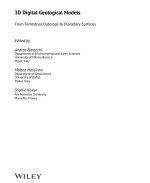Добрый день, Коллеги. Важное сообщение, просьба принять участие. Музей Ферсмана ищет помощь для реставрационных работ в помещении. Подробности по ссылке
3D digital geological models. From terrestrial outcrops to planetary surfaces / 3D цифровые модели. От естественных обнажений до планетарных поверхностей
Collecting quantitative data to support geological analysis and modelling is nowadays a fundamental requirement in all geology disciplines, including structural geology, stratigraphy, and geomorphology, on the Earth and on planetary bodies of the Solar System. In many cases the answer to this need is a Digital Outcrop Model (DOM), a Digital Elevation Model (DEM), or a Shape Model (SM): this can be a digital representation of an outcrop or topographic surface, or of a whole small body (asteroid or comet nucleus) for an SM, generally combined with imagery, that can be quantitatively visualized andstudied in 3D, with the goal of obtaining quantitative measurements.
3D datasets and models for geological purposes include different complementary products: DEMs, DOMs, SMs, and subsurface models. The main differences among these different products are: (i) their nature, since DEMs, DOMs, and SMs represent relief surfaces showing outcropping geological structures that are completely accessible to characterization (up to some precision/resolution), while subsurface models reproduce inaccessible subsurface geological structures with some unavoidable level of uncertainty (hence they are models); and (ii) their topology/dimensionality, as DEMs are actually 2.5D surfaces, generally covering large areas, DOMs are truly 3D surfaces, including multivalued reliefs (e.g. complex or overhanging reliefs, cliffs, caves, etc.), but are generally limited to smaller-scale outcrops, and SMs are closed surfaces covering a whole small body, where subsurface models are essentially volumetric.
In this volume we collect various examples of methods and techniques used to collect, analyze, and model 3D datasets, based on one or more supports (DEM, DOM, SM, subsurface model), and on different software tools, remote sensing, and modelling techniques. Reading the chapters authored by experts in different fields, it will become apparent that (i) the fundamental techniques allowing the production of DEMs, DOMs, and SMs through photogrammetry, laser scanning devices, and radar interferometry are well consolidated, and are almost seamlessly shared between the community of scientists working on the Earth and on planetary bodies of the Solar System; (ii) the particular way these techniques are applied in specific geological environments may change and, for instance, acquisition schemes in photogrammetry still represent a potentially critical issue; (iii) DOM, DEM, and SM processing, elaboration and analysis, including the analysis of image data associated with these surfaces, are active fields of research that are subject to continuous improvements; and (iv) the production of subsurface geological models based (also) on surface data is still not very common, particularly in planetary geology contexts.
One of the aims of this volume is to disclose the numerous points that geological disciplines have in common in applications on the Earth and on planetary bodies of the Solar System, and to favor the communication and collaboration between different scientific communities.




